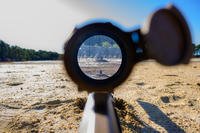 The military's top research arm is finishing work to develop field-deployable prototypes of a sniper scope that automatically measures crosswind and range for a target.
The military's top research arm is finishing work to develop field-deployable prototypes of a sniper scope that automatically measures crosswind and range for a target.
Called One Shot XG, this is the next generation of the One Shot system. The Defense Advanced Research Projects Agency first started working on the One Shot sniper system in 2006 in order to increase the percentage of sniper one-shot kills.
The original One Shot system required a spotter/observer. The goal of the XG version of the program is to create a significantly smaller “field-ready system” that can be “clipped-on” directly to the weapon, according to DARPA.
This spring, the agency is on pace to complete the hardware and software for the XG program in order to produce prototypes that the services can use in field tests.
DARPA researchers completed its own field tests using a brass-board system "to develop and validate wind and measurement algorithms," according to the agency. The One Shot XG team has since designed the hardware and software for the objective system. Work has begun to integrate these systems onto the field-deployable prototypes.
The One Shot XG team has set out goals to develop a system capable of measuring all "relevant physical phenomena that influence the ballistic trajectory, and rapidly calculate and display the offset aim point and confidence metric in the shooter's riflescope. The system should provide the ability to see the aim point on the target in either day or night to enable rapid target identification, weapon alignment, measurement of range to target, and the crosspoint profile," according to DARPA specifications.
Engineers are designing the One Shot XG to mount on a Picatinny Rail. It must be durable and perform in the harsh conditions a rifle might encounter such as a five foot drop onto packed soil and temperatures ranging from -20-49 degrees Celsius.
The integrated measurement scope must be able to measure crosswind and range in less than 3 seconds. It must be able to measure crosswind at a range of 1,500 meters during the day and 800 meters at night. And it must measure crosswinds up up to 15 m/s. It must also have a "range finder range of <100 meters to up to 2,000 meters +/- 1 meter on E-size target," according to DARPA specifications.
When mounted, the One Shot XG system "should not interfere with the riflescope when using in-line night sights such as PVS-22, 27 and thermal sight such as FLIR HISS," according to DARPA. It should also be mounted in a manner that does not "impede normal operation, supports the use of current rifle scopes with first focal plane reticles, and provides full capability against an E-silhouette target at the maximum effective range of the weapon."








